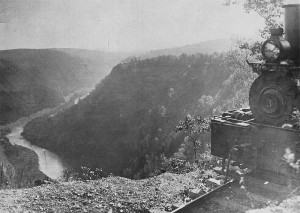Pine Creek Gorge, or the Grand Canyon of Pennsylvania
May 28, 2015
After breakfast in the barn, we turned toward Pine Creek Gorge at Leonard Harrison State Park (the eastern overlook). Before we could get there, J. had to stop at an unexpected Harley-Davidson dealership in Galeton (Larry’s) for gifts. After looking around, I returned to the car and watched two older men lust after a bike parked a few spots down. The owner appeared and shared the specs and some of his adventures on it (I heard “Tennessee” among others). One man never stopped moving around the bike, drinking in its details. To me it seemed unremarkable, but he looked like an art collector sizing up a reputed da Vinci.
The drive along country roads always seems longer than expected, especially when their condition isn’t great and the ever-present threat of deer and/or trucks looms. We made it at last and found a long, deep, curving gorge, the “Grand Canyon of Pennsylvania,” the green of the forest nearly unbroken except for the creek.
Pine Creek Gorge wasn’t always so verdant. After we took many photos and J. wandered a short way down a trail, we watched a video at the visitor center that showed the voracious cutting of the gorge’s old-growth white pine and eastern hemlock. Where men of the time saw money and profits, I saw only destruction and devastation. First they cut the white pine, then the eastern hemlock, then the hardwoods. Clear cutting replaced selective harvesting, leaving denuded hills behind. My heart broke to see the “Grand Canyon” reduced to the “Pennsylvania Desert.” Did no one foresee the result of clear cutting or care?
Today, thanks partly to the efforts of the Civilian Conservation Corps, second-growth forest covers the gorge, and wildlife has returned. This north central part of the state, including Allegheny National Forest, has been branded the “Pennsylvania Wilds,” which attracts hikers, cyclists, fishers, skiers and snowboarders. The men who profited from destroying the forest are long dead, their legacy a reminder of the foolishness of benefiting in the short term at the expense of the future. I hope the Wilds can be sustainable as a tourist attraction because there are few places like it left.
We picked up a couple of Pennsylvania State Parks and State Forests Passports, the state’s answer to the National Park Service’s stamp book program. You don’t have to be a kid to get a kick out of filling your book with stamps!
On the way back we stopped at an unusual church (United Methodist Congregation) and took photos. Later we realized it was featured on postcards we’d bought.
We visited Wellsboro, which is an impressive old town with impressive old houses lining the streets, and stopped at Peggy’s Candies and Gifts for Hershey’s ice cream. If you’re thinking of the Hershey Company (1894), you’d be as wrong as I was. Hershey’s ice cream (also 1894) is a different company with a different history. I thought there have to be trademark attorneys itching to tackle that, and I wasn’t wrong.
The weather looked better than I expected for the visit to Cherry Springs State Park — the long-term prediction had been for clouds and rain. We left around 8:45 p.m. so we’d have some light to see on the unfamiliar roads with their ubiquitous deer. When we arrived at the parking lot, a man ensconced in his car pointed us toward a nearby field with some picnic tables for regular folks.
For a long time we weren’t sure we were in the right place. No one else appeared. We wandered over to the astronomers’ field, but no one showed up there, either. J. agreed we probably weren’t supposed to be there (it’s set up for professionals and amateurs with telescopes and has better restrooms).
The weather wasn’t the reason there were only a few people, mostly near the parking lot and usually for a short time. It was surprisingly good. It was the moon. The bright quarter moon.
I spent the first few years of my life near a dark field (by Chicago standards), but I had forgotten how bright a quarter moon is. We could see more stars than anywhere else, but the moon’s reflected glare obliterated most of the less brilliant stars, leaving some familiar planets and constellations in view. It was quiet, peaceful, and comforting to see the night sky in a way I haven’t been able to for decades. Many Americans have never experienced the magic of the night sky the way our ancestors did, and that is awful and sad.
J. took some photos, and we stayed until about 1 a.m. (If only we could have held out until 3:30 or so, the moon was due to set, although then the light from the dawning sun would have followed soon after.)
Before we left, J. said, “What’s that?” and in the cold moonlight I saw what looked like a weasel shuffling among the uncut grasses. I shone the red flashlight on it and discovered I wasn’t far off — it was a skunk, a member of the mustelid family. It seemed unconcerned, so I got closer than I should have, given a skunk can spray up to 10 feet accurately. It didn’t give me a warning, and when it wandered off I didn’t follow. It’s not often I get to see a skunk that’s not flat and covered in gore.
Again I was relieved to get back to base without hitting Bambi, his mother, or any of his millions of relatives.



















Comments
Pine Creek Gorge, or the Grand Canyon of Pennsylvania — No Comments
HTML tags allowed in your comment: <a href="" title=""> <abbr title=""> <acronym title=""> <b> <blockquote cite=""> <cite> <code> <del datetime=""> <em> <i> <q cite=""> <s> <strike> <strong>